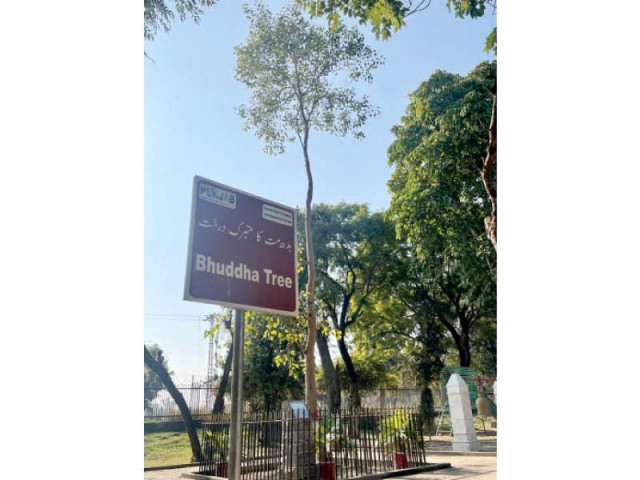Bodhi Tree — symbol of ‘awakening’ for Buddhists
Sacred tree present in Taxila Museum Park since 1964

The Bodhi Tree, also known as the Tree of Enlightenment, is a sacred symbol of faith for the followers of Buddhism.
The historical and religious significance of the Bodhi Tree dates back to 2,500 years ago, when the eventual founder of Buddhism left a life of luxury behind to seek enlightenment, or the ultimate purpose of life.
It is said that Siddhartha Gautama, later known as the Buddha, sat under a sacred fig tree in Bodh Gaya, associated with the Mahabodhi Temple Complex in Gaya district in the Indian state of Bihar, and entered a complete meditative trance.
After the passage of seven weeks, the Buddha is said to have achieved the state of ‘awakening’, and the tree that provided shade and shelter to him came to be known as the Bodhi Tree.
According to ancient texts, devotees of Buddhism carried branches of the original Bodhi Tree to great distances and planted them in various locations. It is believed that any Bodhi Tree in existence around the world is a direct descendant of the one under which the Buddha had meditated.
Conversely, the Taxila Museum is also home to one of these sacred trees.
Sanghmitra, the daughter of the famed King Ashoka—a devout follower and proponent of Buddishm in the sub-continent— is said to have travelled with a branch from the original Bodhi Tree to Anuradhapura in Sri Lanka, where it is still flourishing as an imposing tree.
A branch of this Bodhi Tree was presented to President Ayub Khan when he visited Sri Lanka in December 1963. Former Foreign Minister Zulfiqar Ali Bhutto planted the same branch in the Taxila Museum Park on January 23, 1964.
Although the branch grew up to become a sturdy specimen, most of the people in Pakistan remain woefully ignorant of the rich and awe-inspiring history and significance of the existence of the tree.
Read More: Gandhara Festival at Taxila Museum ends
Even among those who are aware of or have studied the Gandhara Civilisation in some capacity, only a small number of history enthusiasts know that the Bodhi Tree in Taxila is said to be a progeny of the same tree under which the Buddha meditated for seven weeks, attained enlightenment and gazed at with gratitude for as long as seven days.
For Buddhists, the Bodhi Trees are revered as sacred living beings with a direct connection to their beloved spiritual teacher and leader.
Renowned historian and Gandhara Civilisation expert Dr Nadeem Omar Tarar told The Express Tribune that despite the rich history attached with the Bodhi Tree at Taxila, the historical specimen has not been accorded the importance it deserves.
Far from receiving special attention, the Tree is almost lost from view due to its close proximity to a thicket of other large trees, which is affecting its growth and overall health.
The historian has termed the Bodhi Tree a national treasure that can play a vital role in encouraging and promoting religious tourism.
Dr Tarar urged the government to engage the services of archaeologists and arboriculturalists to preserve the sacred tree.
The followers of Buddha celebrate December 8 as Bodhi Day, which is believed to be the day when the Buddha had ‘awakened’. Special meals such as Kheer and cookies shapes like hearts—reflecting the heart-shaped leaves of the Bodhi Tree— are prepared on the day.
Published in The Express Tribune, December 8th, 2021.


















COMMENTS
Comments are moderated and generally will be posted if they are on-topic and not abusive.
For more information, please see our Comments FAQ